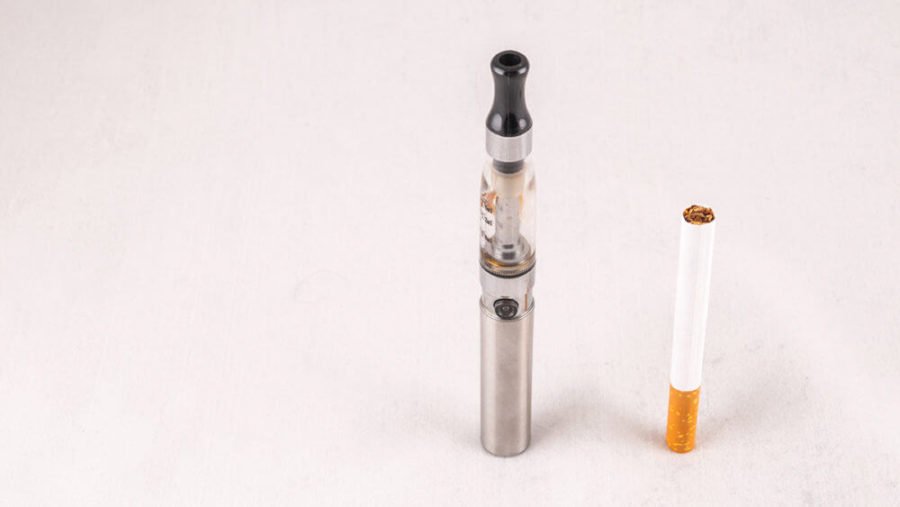E-cigarettes are now the most popular product used for smoking cessation in the United States, ahead of all U.S. Food and Drug Administration (FDA)-approved cessation aids combined, from nicotine patches and gum to prescription medications. However, two recently published analyses of a large nationally representative longitudinal study report that e-cigarettes are not effective in helping adults to quit smoking. However, more research is needed to identify whether these findings also extend to newer e-cigarette designs, which may deliver nicotine as effectively as cigarettes.
The analyses were led by University of California San Diego School of Medicine researchers using data from the Population Assessment of Tobacco and Health (PATH) Study, a longitudinal study of tobacco use and its effect on the health of people in the United States. The PATH Study, undertaken by the National Institute on Drug Abuse (NIDA) and the FDA Center for Tobacco Products under contract to Westat, enrolled a nationally representative sample of 45,971 adults and youth between September 2013 and December 2014 and re-interviewed them annually for the first four years.
The analysis, published online September 2, 2020 in the journal PLOS ONE, considered 2,770 daily smokers who reported trying to quit smoking during the first follow-up year; 23.5 percent used e-cigarettes in 2014-15 (before nicotine salt technology in e-cigarettes) to help with their quit attempt. At the second follow-up one year later, 9.6 percent of e-cigarette users had been abstinent from smoking over the previous 12 months compared to 9.5 percent who did not use an e-cigarette and 10.2 percent who used neither an e-cigarette or a pharmaceutical aid. There was no evidence that cessation rates differed between e-cigarette users and closely matched smokers who did not use e-cigarettes.
“Among this representative sample of U.S. smokers trying to quit, we found no evidence that e-cigarettes were helpful in the quit attempt,” said John P. Pierce, PhD, Professor Emeritus of Cancer Prevention at UC San Diego Moores Cancer Center and the study’s first author. “This lack of effectiveness was also apparent in the sub-sample who used e-cigarettes on a daily basis for this quit attempt.”
The second analysis, published online on July 27, 2020 in the American Journal of Epidemiology, considered 2,535 daily and non-daily smokers from the PATH Study’s wave 2 survey who reported making a quit attempt during the next follow-up year. Seventeen percent of these used e-cigarettes to help with the quit attempt in 2015-16 (also before the increase in sales of e-cigarettes with nicotine salt technology). At the subsequent wave 4 follow up survey, 13 percent reported not smoking for at least 12 months — a somewhat higher rate than the in first analysis (PLOS One paper), attributed to the inclusion of non-daily smokers who are known to have higher quit rates.
Again, study authors said there was no evidence that cessation rates differed from closely matched smokers who did not use e-cigarettes. However, in this analysis, it was clear that participants who used e-cigarettes to quit smoking were less likely to be nicotine-free at follow-up. This was largely because many of those who did quit smoking cigarettes were still using e-cigarettes, which also contain nicotine.
“In these analyses, we carefully matched each smoker who used e-cigarettes as a cessation aid with up to two similar smokers who tried to quit without using e-cigarettes,” said Karen Messer, PhD, professor of family medicine and public health, director of biostatics at UC San Diego Moores Cancer Center and senior author on both papers. “Our results suggest that these smokers would have been just as successful in quitting smoking without the use of e-cigarettes. However, without the use of e-cigarettes they would have been more successful in breaking their nicotine dependence.”
Co-authors for the PLOS ONE study, include: Tarik Benmarhnia, Ruifeng Chen, Martha White, Sheila Kealey. and Dennis R. Trinidad, all of UC San Diego; David B. Abrams and Raymond S. Niaura, of New York University; Bridget K. Ambrose, Nicolette Borek, Blair Coleman, James Henrie, Jean Limpert, Carolina Ramôa, Ethel Taylor, and Lisa D. Gardner, all of the Food and Drug Administration; Carlos Blanco, Kelvin Choi, Wilson M. Compton, and Heather L. Kimmel, all of the National Institutes of Health; K. Michael Cummings, Medical University of South Carolina; Cristine D. Delnevo and Michael B. Steinberg, of Rutgers Center for Tobacco Studies; Tara Elton-Marshall, Centre for Addiction and Mental Health; Maciej L. Goniewicz, Karin A. Kasza, and Maansi Bansal-Travers, all of Roswell Park Comprehensive Cancer Center; Shannon Gravely, University of Waterloo; Geoffrey T. Fong, University of Waterloo and Ontario Institute for Cancer Research; Dorothy Hatsukami, University of Minnesota; Eva Sharma and Cassandra A. Stanton, of Westat; Marushka L. Silveira, National Institutes of Health and Kelly Government Solutions; Andrew Hyland, Roswell Park Comprehensive Cancer Center and Westat; and Samir Soneji, Gillings School of Global Public Health.
This research was funded, in part, by the National Institute on Drug Abuse, National Institutes of Health and the Food and Drug Administration’s Center for Tobacco Products under contract to Westat (HHSN271201100027C).
Disclosures: Cummings has received payment as a consultant to Pfizer, Inc., for service on an external advisory panel to assess ways to improve smoking cessation delivery in health care settings. He also has served as paid expert witness in litigation filed against the tobacco industry. Goniewicz receives fees for serving on an advisory board from Johnson & Johnson and grant support from Pfizer. Compton reports long-term stock holdings in General Electric Company, 3M Company and Pfizer Incorporated, unrelated to this manuscript.
Co-authors for the American Journal of Epidemiology study include: Ruifeng Chen, Eric C. Leas, Martha M. White, Sheila Kealey, David R. Strong, Dennis R. Trinidad, and Tarik Benmarhnia, all of UC San Diego.
This research was funded, in part, by the National Institutes of Health (RO1CA234539) as well as the California Tobacco-related Disease Research Program (28IR-0066).
Disclosures: Pierce and Strong report grants from National Cancer Institute during the conduct of the study. White reports grants from National Institutes of Health during the conduct of the study.


